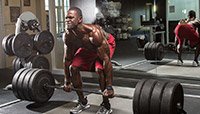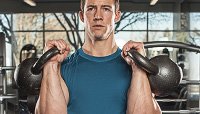
The Right Tools For All Types Of Weight Training!
Long-term lifters know that some types of weights are great for one movement, but less than optimal for others. Save yourself years of trouble with this guide!
Put me in most situations where I have to fix something or use a tool, and I'm a walking, talking epic fail. I know admitting this is sacrilegious, but outside of knowing the difference between a regular screwdriver and a Phillips-head screwdriver, I'm arguably the least mechanically inclined person with a Y chromosome on earth. (As if saying "regular screwdriver" didn't give it away!)
However, put me in a weight room and I'm pretty much MacGyver. Tell me what you want to do, and chances are good I can help you do it. I may not be able to lift a barbell using only a roll of duct tape, a paper clip, and a rubber ducky, but I can definitely help you navigate your options in the gym and figure out which one is the best for what you want to achieve.
Ever find yourself wondering "What should I do with that thing?" Here's your answer!
Barbells
Best for building strength using simple, efficient programming
As a strength coach, I like to keep things simple whenever possible. This is one reason I have a special affinity for barbells.
People have long built impressive physiques and strength only using barbells. Back in the day, machine brands like Cybex, Hammer Strength, Free Motion, and Lifeline didn't exist. People squatted, deadlifted, pressed, lunged, and rowed with a single bar—and got by just fine, thank you very much.
This isn't to suggest that the brands mentioned above aren't useful, but rather to emphasize that you don't need fancy equipment to add muscle and get strong. In fact I'd make the case that if you limited yourself to only using a barbell for a while, you'd make markedly more progress—assuming, of course, that you're utilizing some form of progressive overload.
A barbell will force you to place a premium on classic movements—squat, deadlift, press, row—that have been shown time and time again to work, if you learn to do them right. That's a big "if," of course! For example, here's how to perform the barbell row correctly:
TonyGentilcore.com Barbell Bent Over Row Tutorial
Watch The Video - 3:00
Another reason I like barbells is that they demand time and practice. That may sound like a downside, but it's not. Most nonelite lifters actually need a lot less variety in their training than they think—especially if their goal is to build strength. If you do the work to get proficient—not elite, just proficient— at the classic movements with a barbell, you'll be set for a long time to come.
Dumbbells
Best for presses, upper-body hypertrophy, squat patterning
Dumbbells are in the same camp as barbells, in that they have nothing left to prove. We know they work! However, they offer some advantages that barbells don't. For example, if chest hypertrophy is your goal, dumbbells are slightly superior over a barbell.
Yes, I know, a barbell allows you to lift more weight. That's an important component of muscle growth, but not the only one. So is picking movements that match the way your muscles work! One of the major actions of the pectoral muscles—specifically the pec major—is to adduct the humerus, or upper arm (think flapping your arms down toward your body). It's really hard to accomplish this with a barbell, but occurs fairly naturally during dumbbell press variations.
Dumbbell pressing variations are known to be far more shoulder-friendly. Pressing with a barbell locks you into a pronated (overhand grip) position, which in turn locks the humerus into an internally rotated position, increasing the likelihood of painful shoulder impingement. Pressing with a dumbbell allows for more wiggle room, and if held in a more neutral (palms facing in) position encourages external rotation of the humerus and "opening up" the subacromial space. The upshot: Less shoulder stress, less pain. 'Nuff said!
TonyGentilcore.com 1-Arm Offset DB Press
Watch The Video - 0:09
Another point in favor of dumbbells: I have yet to find a better alternative for grooving a better squat pattern than dumbbell goblet squats. The anterior load offers a perfect counterbalance to help people learn a more posterior weight shift (pushing hips back), in addition to forcing the anterior core musculature to fire to provide more stability.
I also love offset loaded (one side only) dumbbell presses or lunge variations. Not only are they an excellent way to address any muscular imbalances, but they also challenge the core. Next time you're in the gym, perform a few sets of one-arm dumbbell presses off a flat bench, or one-arm dumbbell reverse lunges, and tell me you don't feel your core fire like crazy!
TonyGentilcore.com 1-Arm Offset DB Reverse Lunge
Watch The Video - 0:10
Kettlebells
Best for swings and get-ups
I'm often amazed by how fanatical some people are when it comes to kettlebells. I've heard a few of them make the assertion that a kettlebell trumps anything you could perform with a dumbbell. Kettlebell squats are better than dumbbell squats. Kettlebell presses are better than dumbbell presses, kettlebell rows are better than dumbbells rows, kettlebell swings are better than dumbbell swings. Kettlebells are better than anything, ever!
In fact, I'm writing this article with a kettlebell.
Don't get me wrong: I like kettlebells—a lot. I use them with my athletes and clients, and I use them in my own training. As with everything, though, I consider them a tool. That being said, I won't deny they're better suited for certain movements. One example is the get-up, which I discussed in the article "Two Simple Drills to Nail Difficult Lifts." Another is the swing.
TonyGentilcore.com Kettlebell Swing Tutorial with Iron Body Studios
Watch The Video - 6:49
I do feel that, when you're in a pinch and a kettlebell isn't available, a dumbbell swing is a perfectly fine substitute—and not inherently less effective or more dangerous, as some would claim. But kettlebells do reign supreme here, so if you can use one, by all means do it!
Suspension Trainers
Best for learning movement patterns, corrective work
Even gyms that don't have heavy barbells or power racks these days usually offer some sort of suspension system, like a TRX or Jungle Gym. This is great, because these tools can do plenty to help trainees who aren't ready for big weights.
As an example, I have an older male client who, when we first started meeting, had the movement quality of a pregnant rhinoceros and hadn't performed a squat since, well, let's just say it'd been a while. In a matter of minutes I had him performing decent squats with ease using the TRX.
TRX Anti-Rotation Press
Watch The Video - 0:18
Likewise, when working with an injured, obese, or deconditioned client, my objective as their coach is to show them success no matter what. I'm not going to have them attempt anything that oversteps their ability. I want to set the precedent that, no matter what, "You can do this!" and help them get on the path of learning and progressing as quickly as possible.
This is where suspension trainers work their magic. Whether you want to squat, lunge, or row, the TRX makes quality strength training more accessible.
But don't take that to mean it can't offer a challenge for people past the novice stage. It's also great for the type of core stabilization work I talked about in "The Ultimate Palloff Press Guide." Even advanced lifters can usually use more of that!
TRX Busdriver
Watch The Video - 0:19
Build your best program
Read through this list again, and a program begins to take shape:
- Barbells for strength
- Dumbbells for presses and general swolitude
- Kettlebells for power and conditioning
- TRX for core strength, stability, and corrective work
It bears a decent resemblance to the 8-Week Beginner's Program I wrote a few months back. That's no coincidence.
Everyone—at every skill level—can use more quality training. Sometimes, getting it is as simple as picking the right tool for the job.
Recommended For You

2 Simple Drills To Nail Difficult Lifts
Want to pull an impressive weight off the floor or hoist it over your head? The secret lies in your lats. Use these two simple drills to harness your back's powerful stabilizers!
6 Things To Do With A Heavy Kettlebell
Somewhere in your gym, there's probably a heavy kettlebell with your name on it. Training with it doesn't have to be complicated. Just pick it up and try to hold on!

